
The University of Arkansas Campus Historic District is a historic district that was listed on the National Register of Historic Places on September 23, 2009. The district covers the historic core of the University of Arkansas campus, including 25 buildings.

The Winslow Ames House is a prefabricated modular International Style house in New London, Connecticut, United States. It was designed by Robert W. McLaughlin, Jr. and was built in 1933. Winslow Ames, a professor of art history at Connecticut College and the art director of the Lyman Allyn Museum, had the home built after attending the Century of Progress Exposition in Chicago. Constructed for $7,500, the prefabricated house is one of two surviving Motohomes produced by McLaughlin's company American Houses Inc. The modular house, comprising three rectangles and a flat roof, was constructed on a concrete slab with a welded steel framework. It was made with asbestos panels and features a core component that provides the heating and plumbing functions for the house. The other two modules feature two bedrooms and a one-car garage.

The War Eagle Bridge is a historic bridge in War Eagle, Arkansas, United States, that is listed on the National Register of Historic Places.

The Frauenthal & Schwarz Building, also known as the Front Street Mall. is a historic commercial building at 824 Front Street in Conway, Arkansas. It was designed by architects Sanders & Ginocchio and built in 1925 as a major expansion and renovation of an 1879 building. It is a two-story structure, built of brick, steel, and concrete. Its ground floor storefront consists of plate glass windows and two double-leaf doorways, sheltered by a flat metal overhang. The upper floor has four groups of six windows, each consisting of larger-paned sections topped by smaller-paned ones. A decorative cornice with Mediterranean touches and flattened Italianate brackets extends above them. The building is one of the city's architecturally finest surviving commercial structures of the 1920s, designed by a prominent firm.
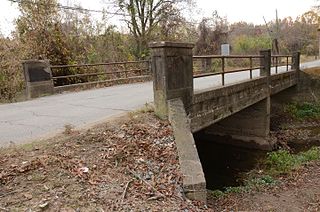
The North Washington Street Bridge is a historic bridge in DeWitt, Arkansas, USA. Built in 1910, it carries North Washington Street over Holt Branch, just south of Holt Lane, and is the oldest known concrete bridge span in the state. It consists of two spans of steel girders, resting on concrete abutments and a concrete central pier, with concrete decking. It is 40 feet (12 m) long and has a roadbed 15 feet (4.6 m) wide. Its guard rails consist of metal piping mounted on concrete piers with simple recessed panels as a decorative effect. The short spans of the bridge demonstrate the unfamiliarity with the use of concrete as a bridge-building material.

The North Jackson Street Bridge is a historic bridge in De Witt, Arkansas. Built c. 1910, it carries North Jackson Street over Holt Branch, just south of North Circle Drive. It consists of two spans of steel girders, resting on concrete abutments and a concrete central pier, with concrete decking. It is 32 feet (9.8 m) long and has a roadbed 22 feet (6.7 m) wide. Its guard rails consist of poured concrete panels, with incised rectangles on the side. The short spans of the bridge demonstrate the unfamiliarity with the use of concrete as a bridge-building material. North Jackson Street was originally laid out as the principal route out of De Witt heading north.

The Kress Building is a historic commercial building at 210 West Main Street in Blytheville, Arkansas. It is a two-story concrete and steel structure, faced in brick and terra cotta. Built in 1938, it was one of the first buildings in the city to be built using steel framing, and is one of its finest Art Deco structures. The first floor areas are faced in terra cotta, while the second floor is predominantly cream-colored brick. Windows on the second floor are surrounded by ivory terra cotta incised with fluting and shell patterns.

The David L. King is a historic house at 2nd and Kelly Street in Hardy, Arkansas. It is a two-story American Foursquare structure with a hip roof, and is fashioned from locally manufactured concrete blocks. It has a hip-roofed porch extending across its front. The house was built in 1919 for David L. King, a prominent lawyer in Sharp County, and is distinctive as a rare example of residential concrete block construction in the community.

The Sebastian County Road 4G Bridge is a historic bridge in rural Sebastian County, Arkansas. The bridge carries County Road 4 across an unnamed tributary of Sugar Loaf Creek southwest of West Hartford, between County Roads 1 and 243. It has two spans with a total length of 44 feet (13 m). The width is 18 feet (5.5 m) curb-to-curb and 21 feet (6.4 m) overall. The two spans rest on a single center stone pier, and both abutments are also made of stone masonry. The road deck is reinforced concrete with simple concrete railings on the sides. Built in 1940, it is a well-preserved example of a concrete bridge from the World War II era of bridge construction in the state, when steel had become scarce. The bridge was listed on the National Register of Historic Places in 1995.

The Highway 79 Bridge was a historic bridge in Clarendon, Arkansas. It was a tall two-span Warren truss bridge, formerly carrying two-lane U.S. Route 79 (US 79), a major arterial highway in the region, across the White River just west of the city's downtown. The steel truss had a total length of 720 feet (220 m), set on four concrete piers. The outer pairs of piers were 160 feet (49 m) apart, and the middle pair were 400 feet (120 m) apart. The approaches were concrete, set on concrete pilings, with the western approach continuing for some 3 miles (4.8 km) across secondary water bodies. The bridge was built in 1930-31 by the Austin Bridge Company.
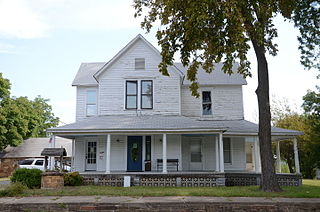
The Bromley-Mills-Treece House is a historic house on Main Street in Marshall, Arkansas. It is a 2 1⁄2-story wood-frame structure, with a cross-gable configuration, clapboard siding, two interior brick chimneys, and a concrete foundation. A single-story porch wraps around two sides of the house, supported by columns on stone piers, with decorative latticework between the bays. Built in 1905, the house is a good example of a well-preserved vernacular structure with minimal Colonial Revival styling.

The Columbus Hatchett House is a historic house at the northern corner of Main and Hazel Streets in Leslie, Arkansas. It is a large two-story structure, fashioned out of rusticated concrete blocks. It has vernacular Colonial Revival details, including egg-and-dart moldings above the window lintels, concrete quoining, Tuscan columns supporting the porch, and ornate Palladian windows. it was built in c. 1910 by Columbus Hatchett using locally fabricated concrete blocks, and is one of the community's finest examples of Colonial Revival architecture.

The Buhler House is a historic house at 1820 Fair Park Boulevard in Little Rock, Arkansas. It is a 2 1⁄2-story structure, its exterior clad in brick, set on a field stone foundation. Stylistically it is in the English Revival, with a tile roof and trim elements of concrete. The house's most distinctive feature is its internal frame, which is constructed entirely out of steel beams. Its exterior and interior door frames are also steel, as is the front door, which has been processed to resemble walnut. It was built in 1930-31 by Henry Buhler, owner of a local real estate development firm. No other residential structure in the state has been documented to have this type of construction.

The Servetus W. Ogan House is a historic house at 504 East Forrest Avenue in Wynne, Arkansas. It is a two-story American Foursquare building, built out of rusticated concrete blocks in 1910. It has a hip roof with hipped dormers, and a projecting single-story porch supported by square columns. It is one of the city's few examples of residential concrete-block construction, a style that was briefly popular in the area.
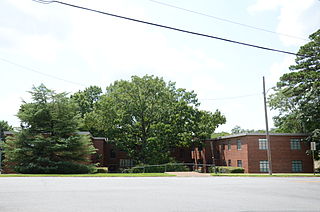
The Prospect Terrace Apartments are a historic apartment complex at 3603 Kavanaugh Boulevard in Little Rock, Arkansas. It is a U-shaped two story brick structure, with a partial concrete basement due to a sloping lot. It is in the austere International Style, with little exterior ornamentation, steel-clad windows, and a flat roof. It was constructed using a design from Edwin B. Cromwell, who was also the first owner of the apartment complex. The building consists of nineteen different housing units.
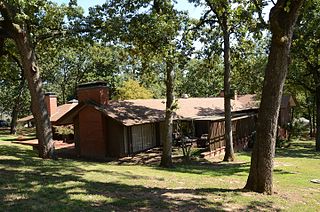
The Oscar Chamber House is a historic house at 3200 South Dallas Street in Fort Smith, Arkansas. Built in 1963–64 to a design by Arkansas architect Ernie Jacks, it is a prominent local example of residential Mid-Century Modern architecture, set in a neighborhood of more conventional ranch and split entry houses. It is a single-story frame structure, with a broad gabled roof, vertical board siding, and a concrete foundation. It has casement windows and sliding glass doors providing access to the outside. The structure is basically a U shape built around a courtyard at the back.

The Scull Historic District encompasses two concrete-block houses at 428 and 432 Conway Boulevard in Conway, Arkansas. These two houses were built about 1928, using a style of ornamental concrete block that were a fashionable building material during the 1920s. Both are single-story structures, with hip roofs and four-column porches recessed under the roof. The houses were probably built by Ferdinand Lawrence Scull, a local manufacturer of the ornamental blocks used in their construction.
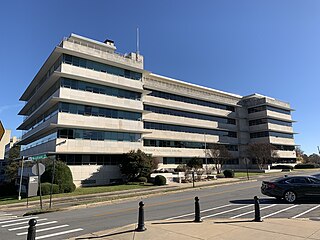
The National Old Line Insurance Company Building is a historic office building at 501 Woodlane Street in Little Rock, Arkansas. It is a modern six-story structure of concrete and steel, occupying much of the city block bounded by Woodlane, Capitol, Sixth, and Victory Streets. It is directly across Woodlane Street from the Arkansas State Capitol, and presently houses state offices. It was designed by Arkansas architect Yandell Johnson and built in 1953–54, with an addition in 1964–54. The exterior is characterized by alternating horizontal bands of windows and limestone panels, which encircle the structure. It is regarded as one of the best examples in the state of the International style of architecture.

The Empire Life Insurance in America Building is a historic commercial building at 2801 West Roosevelt Road in Little Rock, Arkansas. It was built in 1959–60 to a design by the Little Rock firm of Wittenberg, Delony, and Davidson, and is a significant local example of the International style of commercial design. It is a two-story structure of steel and concrete, predominantly faced in glass, aluminum, and fieldstone. The building was given an award by the regional branch of the American Institute of Architects in 1961.

The Block Realty Building is a historic commercial building at 723 West Markham Street in Little Rock, Arkansas. It is a two-story structure, built out of steel and concrete, with a flat roof. It is supported by corten steel columns, with its first floor predominantly finished in glass, and the upper level in aggregate concrete tiles. It was built in 1964 to a design by architect-engineer Eugene Levy, and is a good local example of commercial Mid-Century Modern architecture.




















